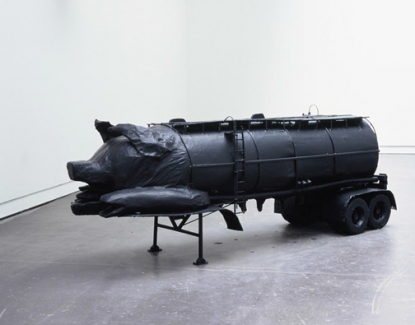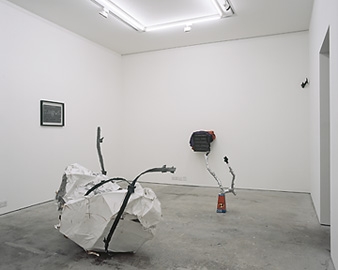Feature: Reviews
Like it Matters
- Centre for Contemporary Arts
- Glasgow, Scotland
- 17 September - 29 October 2005
Imaging Their Erotics, The Ugly Beautiful
I’ve been listening again to the Babybird’s album Ugly Beautiful; so my head is full of the harmonies of: you’re gorgeous, marijuana art pop angst, back bedroom poster protests, and ballads to Coca-Cola. Ugly Beautiful-it’s also the way I am seeing the world at the moment; and could quite easily be the soundtrack to Like it Matters, a show which features the work of three young Glasgow-based artists. Karla Black, Michael Stumpf, and Mick Peter are ugly beautiful; they work with an array of disparate materials producing objects, situations, and internal tensions which are at once absurd, weird, anxious, funny, familiar, gorgeous, fascinating, and harmonious. At the simplest level these artists explore our current relationships to materials and objects, the designed and manufactured; at a more complex level they devise situations and arrangements that reveal a more sinister move towards alienation and skepticism. Perhaps this, in part, explains the inclusion of a previous generation of artists-Bruce Nauman Walking In an Exaggerated Manner Around the Perimeter of A Square (1967-68), Bas Jan Ader Broken Fall (Geometric) (1971), Robert Rauschenberg Linoleum (1967), and Carolee Schneemann Up To and Including Her Limits (1970/1976) in revealing this motion towards the impoverishment of experience. The older generation of artists demonstrate a kind of wide-eyed sense of anticipation, of exploration and experimentation; they show an excited fascination with time-based media and technologies. Rauschenberg’s work shows a mixture of fades and dissolves over found footage and performance experiments, Schneeman shows a galaxy of video color, silhouette and movement which is both erotic and hypnotic. Nauman’s absurdity is a combination of dance and extremes; comedy and obsession. While the younger generation show a more knowing, somewhat constrained body of work that is more representative of our current climate of dismissal, mistrust, and an underlying sense of anticipated danger.
The two generations of artists though, through this merger, create a fusion of art as a process of reimagining possibility, dialogues, and exchanges in the broader context of the time they are or were living in. The older generation is represented by video and film works, the younger by objects and sculpture. Each generation invigorates the other, contextualizing, informing, influencing, rejecting and becoming suspicious of the other. When I first saw this show, I thought the video work was light-based wallpaper to the main event; I had seen these artists’ videos and films before, in isolation and at different times, but what happens is when you see these works again, you see them differently. In this exhibition, these videos and films are seen simultaneously, which not only allows them to correspond to one another but also allows that correspondence to be intercepted by the younger artists object-based works. Like It Matters is about arrangements and rearrangements allowing things, materials, and situations to take on new and better meanings and readings.
Mick Peter’s work combines a strange occasionally moral wisdom with a tough, sometimes touching and naive boyish sculptural sensibility with dashes of slacker and counter-culture imagery. His Pig Tanker (2005) is a hybrid carnivore: consisting of a feasting pig head and oil tanker body: all black, consumption, nature, nurture, heavy-duty industry in solid, sculptural fusion. The oil tanker features little nipples oozing oil droplets onto the gallery floor. Much more of Peter can be seen in his graphic beautifully rendered drawings on his web site; these are often combined with comic book-style commentary and lead us into an astonishing, witty, and eclectic world where the weirdest materials sit beside the weirdest thoughts. This methodology can also be seen in Changing Arranging (2005), featuring a landscape of clay words, objects, heads, and bodies; some of these ‘figures’ made me think of Manga-style robots fashioned by lonely, superhero-fixated adolescent boys. This is a landscape, with its clay inhabitants, for stop-motion animated adventures that combine at once prehistoric material with a spaced-out far-off sci-fi worldliness. Nope (2005) is the least of his works in the show. A massive casino die sits in a solid architectural framework; its only intrigue is its flickering punch-line of scale and familiarity/unfamiliarity. Peter’s work presents solid materials and ideas, but it’s the way he arranges them, allowing for slips and slides, absolute and ambiguous, that’s rather brilliant.
Rather than focusing on references, juxtapositions, appearances, and arrangements, Karla Black’s work is about activities, behaviors, and performances; about the private activities of ‘making’ and the public activities of ‘showing’. Her wide range of materials-petroleum jelly, plaster, nail varnish, plastic packaging, glue, and towels seem to be in states of flux, incompletion, reconsideration, hesitation. Proof of the Cure (2005) is a formless torso-like object, smooth, waxy, and blurred layers of white and pink. It appears like it has been caressed and molded for hours like the record of a durational performance work. The Inherited Traits (2005) sits uncomfortably waiting to be finished; it’s a half-thought, cut through layers of towels and powder, plaster, and paper. Black’s work looks like she’s become distracted but those unfinished thoughts or the half remembered, glimpsed, or unsaid can be magical. Black’s work is the most similar to the work of Bas Jan Ader (represented in this show by his video Broken Fall (Geometric) (1971). His activities, like Black’s, are about physical presence and material alteration, unfinished thoughts, re-imagining situations towards magical, miraculous outcomes and succumbing to natural forces.
The re-imagined sits centrally within the vocabulary of Michael Stumpf. His use of fabric, metal, paper, text, posters, and animations makes reference to cinema and literature and when merged and overlapped evoke new narratives possibilities. Often though these suggested narratives are too inward, too personal, too awkward to be fully engaging. What is the strength of Stumpf’s work, however, is its manufacture, its crafty absurdness, its beautiful peculiarities. The signature of Autograph (2005) is a high glamour cast-resin flash of the artist’s signature; it’s a big high camp high concept joke on authorship, worth, and value. Rock (2005) is a rock, (like a rose is a rose), a massive formless fake rock suspended/thrust into the gallery space and looks like a meteor in a hammock. It reminded me of Maurizio Cattelan’s cosmically intervened, fallen Pope for its wit and weirdness, it’s exaggerated scale, it’s comic effect. This comedy also inhabits the Sound of Leaves (2005), greeting you as you enter the gallery. Stumpf has a fetish for denim (much of his work employs this, the most American and most industrious of fabrics). In this work a pair of jeans are turned into a shamanistic totem for the elaborate, theatrical, the faked, and the exaggerated. It speaks directly in its absurdity and oddness to Bruce Nauman’s film Walking In an Exaggerated Manner Around the Perimeter of a Square (1968-68), which in itself looks at the container of where theater happens, where performance has permission to inhabit. Stumpf like Karla Black shows works where the private activity and behavior surrounding their manufacture is revealed. The pull of Stumpf’s work is imagining those activities and behaviors and understanding how these objects come to reveal themselves.
John Calcutt, who curated this show, has brought together a tempting array of material, conceptual, and artistic goodies; he’s made an arrangement that creates a space where numerous questions and ideas slip around, overlap, are sampled and almost remixed. He’s taken established, influential, critically respected artist’s film and video work and put them in a situation alongside a younger generation of artists whose work is dirty, shabby, and developing creating questions about the influence the older generation has on the younger as well as asserting new ideas about the relationships between the two. Calcutt asks us to question how we view the older generation, and how the younger have reinterpreted their approach, he has asked us to rethink our relationship to all the artists here on show, their worth, the period they are or were working in, their work in relationship to one another and their significance, and it’s both daunting and exciting. As I say it’s both ugly and beautiful.
Karla Black, Mick Peter, Michael Stumpf, Bas Jan Ader, Bruce Nauman, Robert Rauschenberg, Carolee Schneemann
Centre for Contemporary Arts, Glasgow, Scotland
17 September - 29 October 2005
Curated by John Calcutt
www.mickpeter.com
www.cca-glasgow.com


